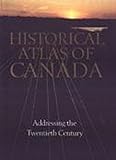Historical Atlas of Canada : Volume III: Addressing the Twentieth Century / ed. by Deryck W. Holdsworth, Donald Kerr.
Material type: TextPublisher: Toronto : University of Toronto Press, [1990]Copyright date: ©1990Description: 1 online resource (197 p.)Content type:
TextPublisher: Toronto : University of Toronto Press, [1990]Copyright date: ©1990Description: 1 online resource (197 p.)Content type: - 9780802034489
- 9781442675766
- 911/.71 23
- G1116.S1 H5 1987 vol. 3eb
- online - DeGruyter
| Item type | Current library | Call number | URL | Status | Notes | Barcode | |
|---|---|---|---|---|---|---|---|
 eBook
eBook
|
Biblioteca "Angelicum" Pont. Univ. S.Tommaso d'Aquino Nuvola online | online - DeGruyter (Browse shelf(Opens below)) | Online access | Not for loan (Accesso limitato) | Accesso per gli utenti autorizzati / Access for authorized users | (dgr)9781442675766 |
restricted access online access with authorization star
http://purl.org/coar/access_right/c_16ec
In 1891 the young nation of Canada stood on the brink of a great surge of growth and development. During the seven decades covered in this volume Canada would be transformed from a rural, agricultural society, almost exclusively British and French in background, to an urban, industrial nation with more cultural diversity. These developments are illustrated in the exceptionally vivid plates of the Historical Atlas of Canada, III: Addressing the Twentieth Century.The first part of the volume, the Great Transformation, covers developments from 1891 to 1929, the year the stock market crashed. In this period of economic and social change are charted, among other aspects, land and resource development, the growth of financial institutions, prairie agriculture and the grain-handling system, industrial growth, and changes in education, religion, and social structures. Individual plates include detailed studies of the formation of the United Church of Canada in 1925; the evolution of suburban neighbourhoods in Edmonton; the wave of strikes in 1919; Ukrainian settlement in southern Manitoba in 1901; the interlocking business interests of Toronto financiers in 1913; the formation of the National Hockey League and the rise of spectator sport; and the development of Montreal as a great industrial city.The second part of the volume. Crisis and Response, deals with the Depression, the Second World War, and the post-war boom. Here are charted shifts in the make-up and distribution of the population, a growing range of social services, and the emergence of a national economy. The plates in this section include graphic representations of drought on the Prairies in the 1930S; the routes of unemployed people riding the rails in search of work; the development of Ottawa as the nation's capital; the rise of retail trade; the strong growth in the uranium and petroleum industries; and the spread of television.With unsurpassed clarity, the Atlas presents the forces that have shaped Canadian society today. Anyone who wishes to understand contemporary Canada will find this volume richly rewarding.
Mode of access: Internet via World Wide Web.
In English.
Description based on online resource; title from PDF title page (publisher's Web site, viewed 01. Nov 2023)


